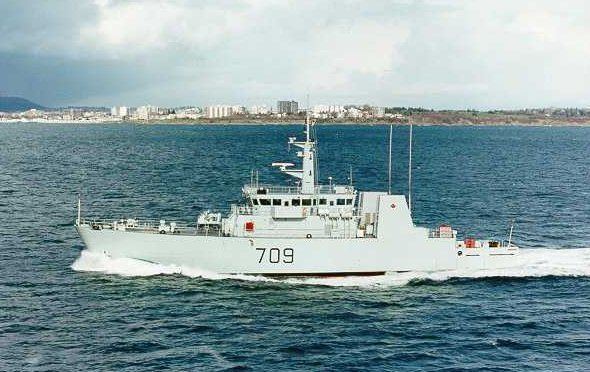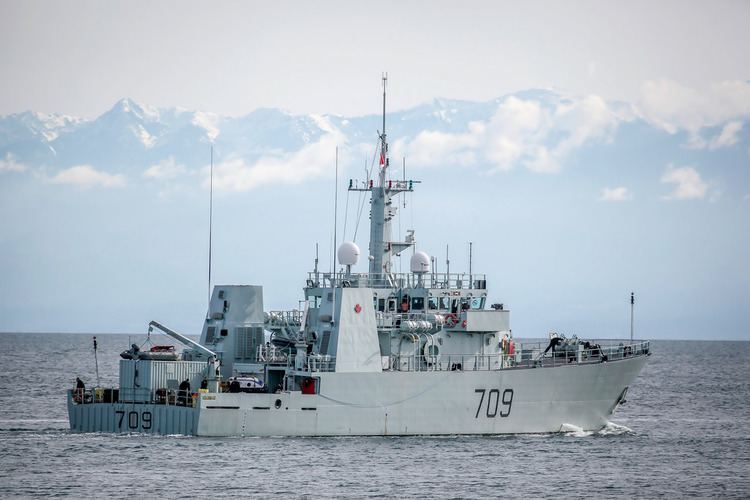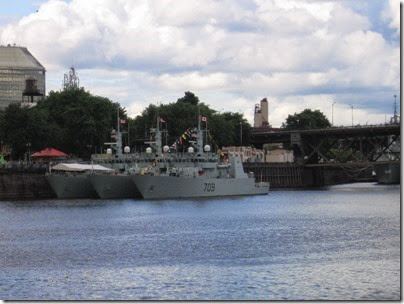Commissioned 5 December 1998 Identification MM 709 Launched 30 March 1998 Draft 3.4 m | Laid down 5 September 1997 Construction started 5 September 1997 Length 55 m | |
 | ||
Namesake Saskatoon, Saskatchewan | ||
Hmcs saskatoon mm 709
HMCS Saskatoon is a Kingston-class coastal defence vessel that has served in the Canadian Forces since 1998. Saskatoon is the tenth ship of her class which is the name for the Maritime Coastal Defence Vessel Project. She is the second vessel to use the designation HMCS Saskatoon. The ship is named after the Canadian city of Saskatoon, and includes other references to the city such as naming the captains desk Cranberry Flats and a main corridor after Idylwyld Drive. She is assigned to Maritime Forces Pacific (MARPAC) and is homeported at CFB Esquimalt.
Contents

Design and description

The Kingston class was designed to fill the minesweeper, coastal patrol and reserve training needs of the Canadian Forces, replacing the Bay-class minesweepers, Porte-class gate vessels and Royal Canadian Mounted Police coastal launches in those roles. In order to perform these varied duties the Kingston-class vessels are designed to carry up to three 6.1-metre (20 ft) ISO containers with power hookups on the open deck aft in order to embark mission-specific payloads. The seven module types available for embarkation include four route survey, two mechanical minesweeping and one bottom inspection modules.

The Kingston class displace 970 long tons (990 t) and are 55.3 metres (181 ft 5 in) long overall with a beam 11.3 metres (37 ft 1 in) and a draught of 3.4 metres (11 ft 2 in). The coastal defence vessels are powered by four Jeumont ANR-53-50 alternators coupled to four Wärtsilä UD 23V12 diesel engines creating 7.2 megawatts (9,700 hp). Two LIPS Z-drive azimuth thrusters are driven by two Jeumont CI 560L motors creating 3,000 horsepower (2,200 kW) and the Z drives can be rotated 360°. This gives the ships a maximum speed of 15 knots (28 km/h; 17 mph) and a range of 5,000 nautical miles (9,300 km; 5,800 mi) at 8 knots (15 km/h; 9.2 mph).

The Kingston class is equipped with a Kelvin Hughes navigational radar using the I band and a Kelvin Hughes 6000 surface search radar scanning the E and F bands. The vessels carry an AN/SQS-511 towed side scan sonar for minesweeping and a Remote-control Mine Hunting System (RMHS). The vessels are equipped with one Bofors 40 mm/60 calibre Mk 5C gun and two M2 machine guns. The Kingston-class coastal defence vessels have a complement of 37.
Construction and career

Saskatoon was laid down on 5 September 1997 by Halifax Shipyards Ltd. at Halifax, Nova Scotia and was launched on 30 March 1998. The ship transferred to the west coast in September and was commissioned into the Canadian Forces on 5 December 1998 at Esquimalt, British Columbia. The coastal defence vessel carries the hull number MM 709.
In 2007, a court martial revealed that a third of the crew of the ship used illicit drugs, namely cocaine. This led to a wider investigation in the Canadian Forces into drug use. In February 2012, Saskatoon took part in Exercise Pacific Guardian, a joint naval exercise with the United States.
In February 2016 Edmonton and Saskatoon took part in Operation Caribbe. On 19 March, Saskatoon intercepted a fishing boat that when discovered, jettisoned its cargo and fled. Saskatoon recovered ten bales or 360 kilograms (790 lb) of cocaine from the water. On 25 March, a patrol aircraft spotted a boat in international waters. The boat, noticing the plane, dumped its cargo and fled. Saskatoon was dispatched to search the area but did not intercept the boat, however, the ship did recover sixteen bales of cocaine totaling 640 kilograms (1,410 lb). Edmonton and Saskatoon returned to Esquimalt on 29 April 2016. In June 2016, Calgary, Vancouver, Saskatoon and Yellowknife sailed from Esquimalt to participate in the RIMPAC naval exercise. On 20 February 2017, Saskatoon left Esquimalt to join Operation Caribbe.
